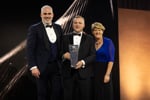Using pyrolysis thermal treatment, a team at the University of Brighton's Environmental Body has found it can recover as much as 12 per cent of ASR as useful iron and up to 40 per cent as fuel gas. It also says that almost half of the material has cement industry potential.
The lion's share of the research was funded by Biffaward, the multi-million pound environment fund which utilises landfill tax credit donated by Biffa Waste Services. Biffaward says car manufacturers - on whom the EC has heaped retrospective responsibility for vehicle disposal - are showing great interest in the results. Most scrap vehicles are shredded into fist-size pieces, but one of the greatest challenges facing carmakers is disposal of the remaining material.
Most of the ASR is too small - below 15mm - for mechanical recovery. That material usually ends up in landfill sites, although European legislation is becoming increasingly aware of land contamination and environmental pollution issues. However, the Brighton University researchers' claim to have optimised operating conditions of a pyrolysis process to produce large quantities of commodity grade iron from fine ASR for recycling in the steel industry has been welcomed with enthusiasm - and relief.
“The ELV Directive has set stringent targets for the recovery of materials from end-of-life vehicles, so the need for this project has been established by legislative, environmental and commercial drivers,” says Biffaward's chairman Martin Bettington. “The Brighton project draws together different techniques to reduce waste from end-of-life vehicles ending up in landfills.”
Biffaward's £152,293 grant included a £15,293 contribution from the Consortium for Automotive Recycling (CARE) - a consortium of 17 car manufacturers working with dismantlers, shredding companies, material recyclers and UK academia.














Login to comment
Comments
No comments have been made yet.